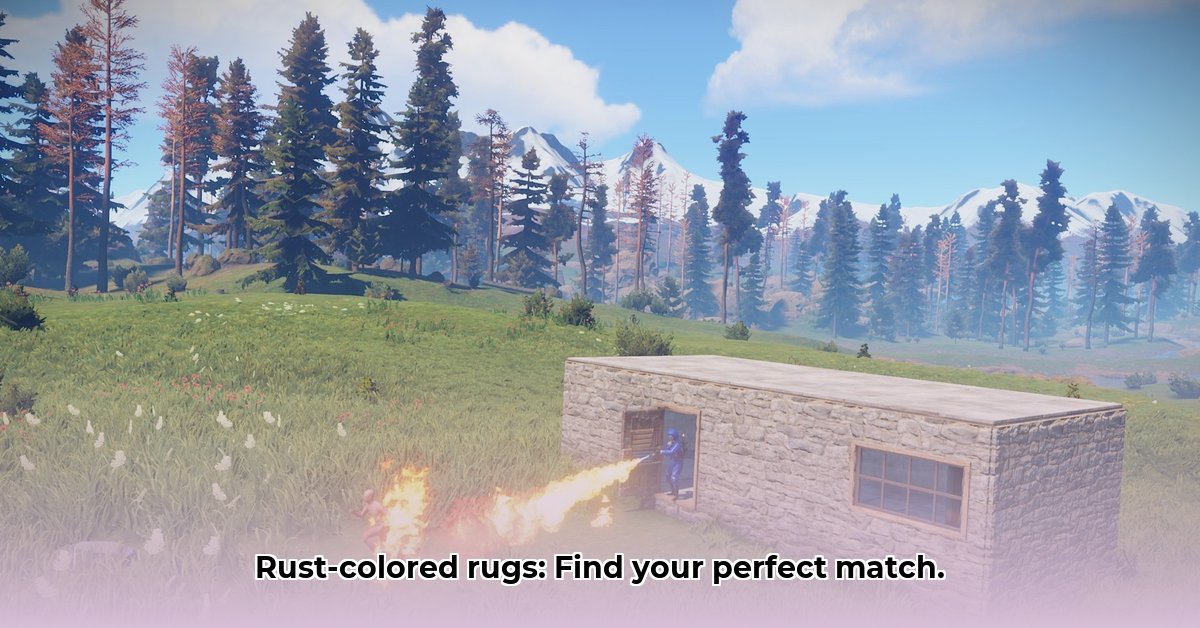Rust-colored rugs are a trending design element, capable of infusing warmth and sophistication into diverse spaces. However, navigating color variations, material options, and stylistic considerations can be challenging. This comprehensive guide provides the insights needed to select the ideal rust rug for your home in 2025. For more red rug options, check out these red rugs.
Understanding Rust-Colored Rugs: A 2025 Perspective
A rust-colored rug introduces warmth and elegance to a room without being visually overpowering. The selection process may initially seem complex, but this guide streamlines it, offering essential knowledge for making an informed decision.
Decoding the Shades of Rust: Navigating Color Variations
The term “rust” encompasses a broad spectrum of hues, ranging from deep burnt orange to reddish-brown terracotta. This diversity, while aesthetically appealing, can complicate the selection process. Room lighting significantly affects the perceived color; a vibrant auburn seen online may appear more orange or muted under different lighting conditions in your home.
To manage expectations and ensure satisfaction:
- Request Samples: Obtain physical samples whenever possible to evaluate the color under your room’s specific lighting conditions.
- Check Multiple Photos: Review product photos under various lighting scenarios (natural, artificial, warm, cool).
- Read Detailed Color Descriptions: Pay close attention to the retailer’s color descriptions, noting any specific undertones or variations.
- Compare Descriptions with Images: Cross-reference the written descriptions with the visual representations to ensure consistency.
Prioritizing Material Selection for Longevity and Comfort
The rug’s material significantly influences its lifespan, texture, maintenance requirements, and overall aesthetic. Selecting the appropriate material enhances your space and ensures long-term satisfaction.
| Material | Pros | Cons | Ideal Room Placement | Considerations |
|---|---|---|---|---|
| Wool | Durable, naturally stain-resistant, luxurious feel, excellent insulation, long-lasting | Expensive, can be tricky to clean, may require professional cleaning, susceptible to moth damage | Living rooms, bedrooms – areas prioritizing softness, durability, and a luxurious feel | Best for areas with moderate to low foot traffic. Consider professional cleaning services for optimal care. |
| Cotton | Soft, affordable, relatively easy to clean, lightweight | Less durable than wool, can shrink if not cared for properly, absorbs moisture easily | Bedrooms, children’s rooms – places where a softer texture and affordability are key | Suitable for light to moderate use. Wash on a gentle cycle and avoid high heat when drying to prevent shrinkage. |
| Jute | Durable, eco-friendly, budget-friendly, adds texture, biodegradable | Rougher texture than wool or cotton, can shed, not as soft, susceptible to water damage | Entryways, high-traffic areas – areas prioritizing durability, eco-friendliness, and a natural aesthetic | Opt for jute rugs in areas where spills are less likely. Regular vacuuming is essential to minimize shedding. Use a rug pad to protect flooring. |
| Synthetic (Polypropylene, Nylon) | Affordable, durable, easy to clean, often stain-resistant, water-resistant, fade-resistant | May not feel as luxurious as natural fibers, may not be as environmentally friendly, can generate static electricity | High-traffic areas, kitchens, bathrooms – places where easy cleaning, stain resistance, and affordability are paramount | Ideal for homes with pets and children. Choose synthetic rugs with a high pile for added comfort. |
Additional Material Considerations:
- Silk: Offers a luxurious sheen and delicate texture, best suited for low-traffic areas.
- Sisal: A durable, natural fiber similar to jute but with a slightly smoother texture.
- Blends: Combinations of different fibers (e.g., wool and synthetic) can offer a balance of benefits and drawbacks.
Select a material based on the room’s function, traffic level, and your lifestyle. Jute or synthetic materials are suitable for high-traffic areas and homes with pets, while wool or cotton are ideal for bedrooms.
Sizing Up Your Space: Achieving Perfect Rug Fit and Placement
The size of the rug significantly impacts the room’s overall aesthetic and functionality. A rug that is too small can appear insignificant, while one that is too large can make the room feel cramped. Follow these steps to achieve an ideal fit:
- Measure Your Space: Accurately measure the dimensions of the area where you plan to place the rug.
- Consider Furniture Placement: Determine whether you want the rug to extend under all furniture legs, only the front legs, or just float in the center of the space.
-
Choose the Right Size: Use these guidelines as a starting point, adjusting based on your specific preferences and room layout:
- Living Room:
- All Legs On: In a larger living room, placing all furniture legs on the rug creates a cohesive and luxurious feel. Ensure at least 18-24 inches of bare floor remain between the rug and the walls.
- Front Legs On: A common approach is to place only the front legs of sofas and chairs on the rug, creating a defined seating area.
- Floating Rug: In smaller spaces, a rug can float in the center of the room, defining a central area without touching any furniture.
- Bedroom:
- Under the Entire Bed: Placing the rug under the entire bed and nightstands creates a unified and comfortable space. Extend the rug at least 2-3 feet beyond the sides and foot of the bed.
- Extending from the Bed: Positioning the rug to extend from the bottom two-thirds of the bed creates a soft landing spot and adds visual interest.
- Runners on the Sides: Place runners on either side of the bed for a touch of comfort and style.
- Dining Room:
- Ensure the rug extends at least 24-36 inches beyond the table on all sides to accommodate chair movement, even when chairs are pulled out.
- Entryway:
- Use a runner or smaller rug to catch dirt and define the entryway space. Choose a durable and easy-to-clean material.
- Living Room:
Pro Tip: Use painter’s tape to map out the rug size on the floor before making a purchase. This visual aid helps ensure the rug fits the space and complements the furniture arrangement.
Harmonizing Design and Budget: Finding the Right Balance
Rust-colored rugs seamlessly integrate into a wide range of design styles, from bohemian and eclectic to modern and traditional. They add rustic charm to farmhouse kitchens, ground mid-century modern living rooms, and complement the earth tones of a bohemian-inspired space.
Let your existing furniture and décor guide your rug selection. Consider the following:
- Color Palette: Choose a rust shade that complements the existing colors in the room.
- Pattern: Opt for a pattern that complements the overall style of the room. Geometric patterns work well in modern spaces, while floral or traditional patterns suit more classic interiors.
- Texture: Consider the texture of the rug in relation to other textures in the room. A shag rug adds warmth and comfort, while a flatweave rug offers a sleek and modern look.
Pricing often reflects the materials used, the complexity of the design, and the craftsmanship involved. While it’s tempting to opt for a budget-friendly option, investing in a higher-quality rug can offer superior durability, longevity, and aesthetic appeal.
Essential Maintenance Tips for Keeping Your Rust Rug Looking Its Best
Regular maintenance is essential for extending the lifespan and preserving the beauty of your rust-colored rug. Specific cleaning methods vary depending on the material.
- Wool:
- Vacuum regularly (2-3 times per week) with a suction-only vacuum cleaner to remove dirt and debris. Avoid using a beater bar, as it can damage the fibers.
- Spot-clean spills immediately with a clean, white cloth. Blot, don’t rub, the stain. Use a mild detergent diluted in water, if necessary.
- Professional cleaning is recommended every 12-18 months for deep cleaning and stain removal.
- Cotton:
- Check the manufacturer’s instructions for cleaning. Some cotton rugs can be machine washed on a gentle cycle with cold water.
- Air dry the rug to prevent shrinkage.
- Avoid using harsh chemicals or bleach.
- Jute:
- Vacuum regularly to prevent dirt and debris from accumulating.
- Spot-clean spills immediately with a clean, dry cloth. Avoid getting the rug wet, as it can damage the fibers.
- Professional cleaning is recommended for deep cleaning.
- Synthetic:
- Vacuum regularly.
- Most synthetic rugs can be spot-cleaned with a mild detergent and water.
- Some synthetic rugs can be machine washed, but check the manufacturer’s instructions first.
General Maintenance Tips:
- Use a rug pad underneath the rug to protect the flooring and prevent slippage.
- Rotate the rug every few months to distribute wear evenly.
- Avoid placing the rug in direct sunlight, as it can fade the colors
- Modern Kitchen Backsplash Ideas To Inspire Your Refresh - December 19, 2025
- Modern Backsplash Ideas: A Guide to Todays Kitchen Trends - December 18, 2025
- Ceramic Kitchen Wall Tiles: Style and Protection for Your Walls - December 17, 2025









